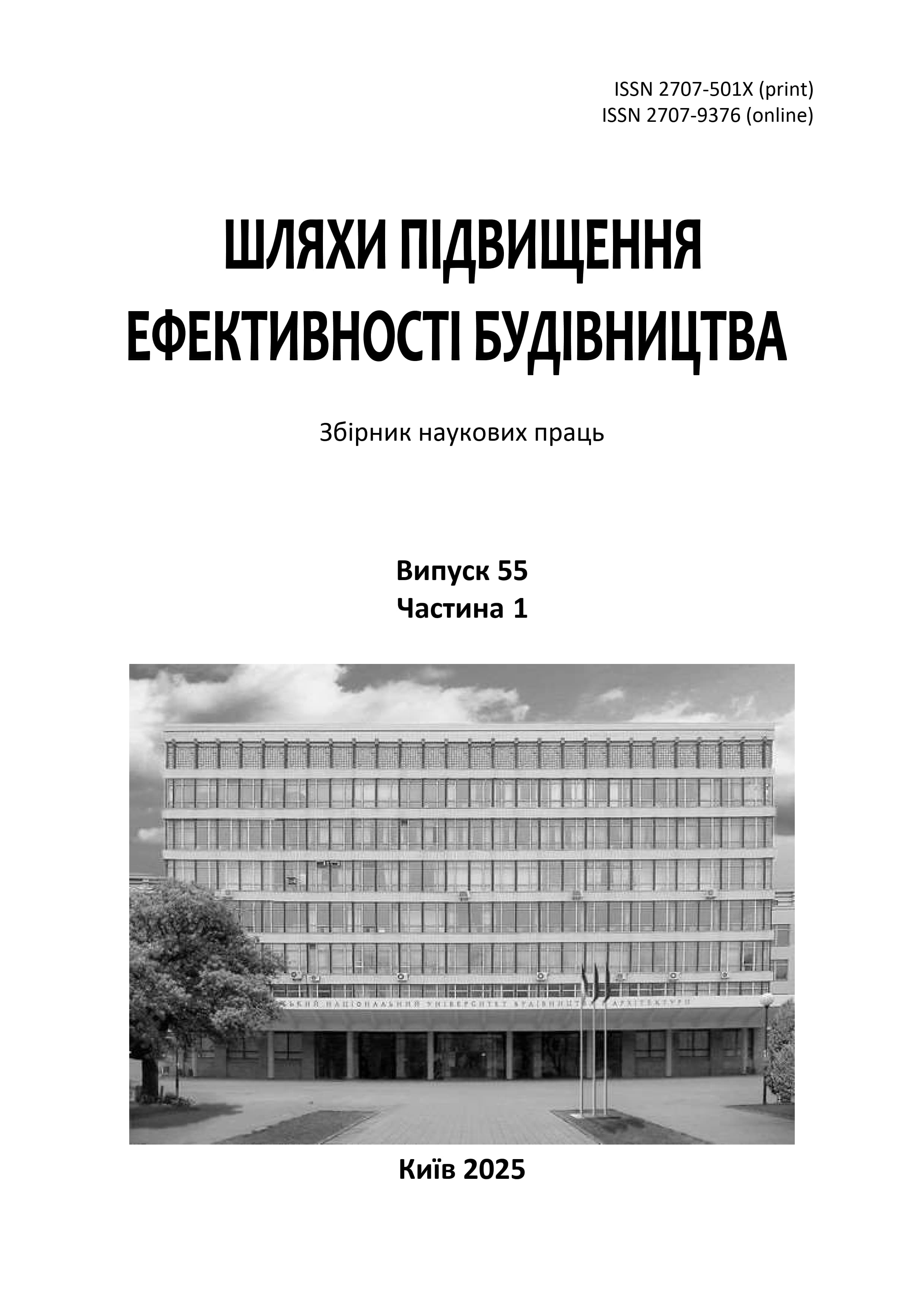Theoretical and methodological basis of an integrated approach to optimization of criteria of the life cycle of a construction development project
DOI:
https://doi.org/10.32347/2707-501x.2025.55(1).183-200Keywords:
project life cycle, construction development, integrated approach, optimization, risk management, BIM, Life Cycle Costing, Value Engineering, digital transformationAbstract
The article is devoted to the study of the theoretical and methodological foundations of an integrated approach to optimization of criteria of the life cycle of a construction development project. In modern conditions of development of the construction market, characterized by high dynamics of changes, growing environmental requirements and the need to increase the efficiency of resource use, the problem of optimization of criteria of the life cycle of development projects is becoming particularly relevant. Traditional methods of management of the life cycle of construction projects often do not take into account the entire spectrum of factors influencing their successful implementation, and also do not provide sufficient flexibility in responding to changes in the external environment.
An integrated approach to optimizing life cycle criteria involves comprehensive consideration of economic, environmental, technological and social aspects of project activities. Particular attention is paid to the analysis of modern concepts of development project management, in particular the Life Cycle Costing (LCC), Value Engineering (VE) and Building Information Modeling (BIM) methodologies, which provide comprehensive resource management and effective decision-making at all stages of the life cycle. It is determined that the main criteria for optimizing the life cycle of a construction project are minimizing costs throughout the cycle, increasing environmental sustainability, ensuring the innovation of design solutions and compliance with the developer's strategic goals. The use of an integrated life cycle assessment model based on a combination of multi-criteria analysis and risk management methods is proposed. Special emphasis is placed on the importance of digitalization of life cycle management processes of development projects. The use of BIM technologies, intelligent data analysis (Big Data), artificial intelligence (AI) and blockchain solutions allows you to automate the processes of planning, implementation and control of projects, which helps to increase their efficiency and reduce risks.
The issue of adaptive life cycle management in the context of modern challenges, such as urbanization, climate change and instability of the economic environment, is also considered. An algorithm for integrating modern management tools into the process of planning and implementing construction projects is proposed, which allows you to increase their flexibility and resistance to external changes. The results of the study can be used to improve the management of construction development projects, develop methodological approaches to assessing their effectiveness, as well as to create new models for optimizing the life cycle of projects taking into account modern market requirements and innovative technologies.
References
Honcharenko T., Chupryna Yu., Ivakhnenko I., Zinchenko M., Tsyfra T. Reengineering of the Construction Companies Based on BIM-technology. International Journal of Emerging Trends in Engineering Research. Volume 8. No. 8, August 2020 pp. 4166-4172. URL: http://www.warse.org/IJETER/static/pdf/file/ijeter22882020.pdf https://doi.org/10.30534/ijeter/2020/22882020
ISO 15686-1:2011. Buildings and constructed assets – Service life planning. Part 1: General principles and framework. International Organization for Standardization, 2011. URL: https://www.iso.org/standard/45798.html
ISO 15686-5:2017. Buildings and constructed assets – Service life planning. Part 5: Life-cycle costing. International Organization for Standardization, 2017. URL: https://www.iso.org/standard/61148.html
Khasreen, M. M., Banfill, P. F., & Menzies, G. F. Life-cycle assessment and the environmental impact of buildings: A review. Sustainability, 1(3), 2009, 674-701. https://doi.org/10.3390/su1030674
Kohler, N., & Moffatt, S. Life-cycle analysis of the built environment. Industry and Environment, 2003. 26(2):17-21.
O'Toole, J. Leading Change: The Argument for Values-Based Leadership. New York: Ballantine Books, 1996. 304 p.
Аксельрод Р.Б. Науково-методологічні засади управління процесами трансформації будівельних підприємств: дис. … д-ра екон. наук: 08.00.04. Київ, 2022. 437 с.
Бугрова О.О. Сучасні підходи до управління життєвим циклом будівельних проєктів. Наукові записки НаУКМА. Економічні науки, 2020. Т. 5. С. 75-82.
Дружинін М.А. Формування загальнометодичних вимог щодо запровадження та побудови інструментарію організаційно-технологічного супровіду проєктів будівництва. Просторовий розвиток, 2024. №7. С. 221-232. https://doi.org/10.32347/2786-7269.2024.7.221-232
Климчук М.М., Івахненко І.С., Порфір’єв Ю.Л. Інтегративно-конвергенціальна методологія реалізації енергоощадного девелопменту в Україні. Економіка та держава, 2019. №11. С. 45-50.
Лисяк Н.М. Теоретико-методологічні засади інтегрованого розвитку урбанізованих систем: автореф. дис. … д-ра екон. наук: 08.00.05. Львів: Національний університет «Львівська політехніка», 2021. 43 с. URL: http://ird.gov.ua/irdd/ar20210930_a805_LysyakNM.pdf
Ткач Т.В. Удосконалення методів оцінки ефективності інвестиційних проєктів у будівництві. Вісник Придніпровської державної академії будівництва та архітектури, 2018. №6. С. 50-56.
Чуприна Х.М., Чуприна Ю.А., Бородавка М.В., Грабчак Д.В. Структурно-когнітивне моделювання на основі інтелектуалізації процесів адміністрування будівельними підприємствами. Формування ринкових відносин в Україні. 2020. Вип. 5 (228). С. 89-98.
Downloads
Published
How to Cite
Issue
Section
License

This work is licensed under a Creative Commons Attribution 4.0 International License.
Authors who publish with this journal agree to the following terms:
- Authors retain copyright and grant the journal right of first publication with the work simultaneously licensed under a Creative Commons Attribution License that allows others to share the work with an acknowledgement of the work's authorship and initial publication in this journal.
- Authors are able to enter into separate, additional contractual arrangements for the non-exclusive distribution of the journal's published version of the work (e.g., post it to an institutional repository or publish it in a book), with an acknowledgement of its initial publication in this journal.
- Authors are permitted and encouraged to post their work online (e.g., in institutional repositories or on their website) prior to and during the submission process, as it can lead to productive exchanges, as well as earlier and greater citation of published work (See The Effect of Open Access).

